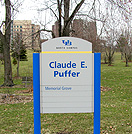Flashback
April’s Fool Day
35 years of special Spectrum issues
A retrospective of the last 35 years of special issues published by The Spectrum to mark April Fool’s Day dramatically documents that draconian scenarios to deal with SUNY budget cuts and UB infrastructure disasters have surfaced consistently in the twisted brains of Spectrum writers.
The issue of 1975 reported that the Ellicott Complex had been condemned when officials discovered that the walls in Red Jacket Quadrangle were constructed of oatmeal. An Amherst resident blasted “those creeps in Albany who spent millions, MILLIONS, on a lemon that squeezed prune juice.”
In 1990, UB administrators reportedly eyed Ellicott’s Kanazawa Island as an “untapped revenue source with staggering economic potential.” Plans were announced to develop the island into “the new hot spot for student recreation on campus,” with canoe rentals, glass-bottomed boat rides and “all the clams you can eat.” Revenues were to be earmarked for an Ellicott-Capen monorail.
Things got worse in 1995. Gov. George Pataki closed UB on April 30, eliminating the remainder of the semester—and final exams. In response to state budget woes, Pataki previously had announced plans to transform the Ellicott Complex into a hotel/casino.
Also that spring, Lockwood Library and the Undergraduate Library were eliminated to cover an immediate UB budget cut. The libraries were the first to go because “books can be found almost everywhere.” All volumes and computers were slated to be sold during a two-week “yard sale.” Students viewed this budgetary maneuver as a “win-win situation,” since professors would “eventually stop handing out research assignments and classes will gradually become easier.”
By 2000, students took things into their own muddy hands to deal with rising tuition and other costs as marijuana patches reportedly were thriving on UB soil. Horticulture students determined that the marshy soil of the North Campus had a perfect pH and the right blend of clay and sand for cultivating weed. The first patch was discovered, appropriately, near a bench in Puffer’s Grove. Other patches quickly sprouted on Kanazawa Island and near Bissell Hall, the campus police headquarters. Studies determined that the original seeds probably “blew here on strong northern winds from Canada.”
To save money in 2005, UB replaced its bus fleet with 20 “pre-owned” yellow school buses provided by a Texas company. The “cheese-colored fleet” was named “Victor E. Bus.” A member of the administration recognized the impact of the fleet: “The sight of a sputtering yellow cheese bus with Victor E. Bull horns cruising down Millersport Highway is just what UB needs to inspire pride in our university.”
UB did get a financial boost in 1995 when it was determined, through information obtained via the Freedom of Information Act, that the Ellicott Complex and its “lego-like dormitories” were built on top of the active Montreal fault line. Due to this geographic coincidence, UB was awarded funding to establish the National Center for Earthquake Engineering Research. While tremors would probably reduce Ellicott into piles of pebbles because it was built over a drained swamp, the rest of the North Campus was safe due to its “very resistant clay-like soil.”
The turning of the millennium and decades of budget woes resulted in this Spectrum front-page framed announcement on April 1, 2000: “Warning!! Tomorrow at 3 p.m. the End of the World will begin. The final frame will start with a brief round of plagues dispersing throughout the world. This will be followed by a torrential downpour of actual cats, dogs and frogs. At approximately 5 p.m., locusts will run wild worldwide.”
Be sharp and vigilant—today is April 1, 2010.
—Judith Adams-Volpe, University Libraries


Reader Comments